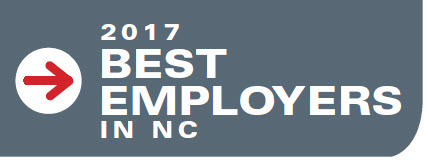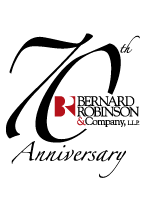 Bernard Robinson & Company ranks number one on the list of the Best Employers in North Carolina (small and medium sized companies) by Business North Carolina! Bernard Robinson & Company ranks number one on the list of the Best Employers in North Carolina (small and medium sized companies) by Business North Carolina!
Click
here
to learn more about why Bernard Robinson & Company is such a great place to work!

|
|
|
Celebrating 70 Years: For the Love of Financial Statements
|
By Ginny Colvin, Quality Assurance Manager
I joined Bernard Robinson & Company, L.L.P. in June 1993 - 24 years ago. I still remember the suit I wore to my interview: it was teal green. I was initially hired to help bring BRC into the 20th century with regard to its computer presence, and to do administrative support. Mr. Bernard Robinson was semi-retired at this point, but came into the office almost every day. The very professional and proper atmosphere of the office was a little daunting to me in my first days. Everyone was very friendly and helpful, but buttoned-up professional. The men of course all wore suits, and the women also had to wear suits (skirts). If the women wanted to wear pants, then it had to be a pant suit (purchased together). I was told not to look Mr. Robinson in the eye, and never ever speak to him unless spoken to first. I came from a large family, raised in the country where everyone talked at the same time and all 10 children were treated as and expected to be individuals. So, I made it my personal challenge to set about changing this proper and austere place - but very quietly, and on the down-low, so no one was aware of it. Soon, Mr. Robinson was greeting me with a smile and asking how I was doing, as I had started doing the same with him. We even started having birthday cakes! I can't take credit for changing the dress code (maybe a little of my free spirit rubbed off), but that changed too, and everyone loved it.
Also, another thing I discovered early on was the very low turnover rate in employees. People just did not leave this place very often. The Firm was just that good to everyone. It may have been professional and austere, but there was tremendous respect for all the work you did, and there were a lot of perks I had not experienced anywhere else. All these things added up to more than 40 years of service from the office manager, more than 30 years for a couple of the accountants, and between 10 and 25 years for others in the administrative department. Most of the positions were created for these people; they were not stepping into someone else's vacated job. Over the past 24 years I have been here, many of the people that were here when I started are either still here or have "aged" out and retired.
In the early days, I reported directly to Bob Shuman, the partner over the operations end of the Firm. I was quite surprised on my first day when I learned that out of the less than 20 person office, there were only a few stand-alone desktop computers. Some of the accountants shared computers and saved all their work to 5¼" floppy disks. Everyone had disk file cases on their desks for all their floppy disks. The partners and the office manager all had stand-alone desktop computers on their desks. The rest of the administrative staff used dedicated word processers, which resembled the console on the Starship Enterprise. Everything was done in pencil, on paper, and every piece of paper was kept! Mr. Shuman and I got to work, and it wasn't too many months before everyone had their own computers and the whole office was networked (wired) together. It also didn't take but a few short years that I learned being an IT person was not for me!
With the advent of the new network system, we did away with the dedicated word processors and dot matrix printers in the administrative department. This brought a new set of duties, including setting up (typing) all the existing clients' financial statements into the system. We tried various software to accomplish this over the years, from Lotus and WordPerfect to finally Excel. The audit and accounting administrative department was where I worked when I wasn't doing "computer" stuff. I soon fell in love....with financial statements. I may be a bit of a free spirit in my thinking about people and interactions, but I am very detailed in my work. I loved the detailed work involved in proofing the financial statements. And I was a sponge. I asked a million questions of the audit partners, much to their dismay at times I'm sure. I have had so much help and encouragement over the years from the entire audit department. Dan Hayes, the head of the Firm's audit department, has been my mentor, teacher and critic for 24 years. So after 24 years, I am still in the audit and accounting department as the Quality Assurance Manager, and I am still in love with financial statements.
|
 |
Planning a Successful Audit
|
|
By Jamie Parsons, CPA, Manager
Annual financial statement audits can be overwhelming for an entity; however they serve a valuable purpose of helping an entity to maintain financial integrity. The key to a successful audit is in the preparation and planning by the management team.
It starts with your accounting system and monthly processes. Your accounting system is likely to be excellent in its everyday uses including revenue billings, receiving payments, paying bills, and processing payroll. With your monthly close, you are likely to review and reconcile various accounts. Strong daily and monthly close processes will pay off well as you close out the year and prepare for the annual audit.
In addition to having great monthly processes, here are a few more ideas to ensure that your annual audits go smoothly:
- Know your significant balance sheet accounts. Make sure you analyze, review and reconcile each one. Prepare a schedule for each significant balance sheet account that captures all the account activity for the year. The formula is simple:
Beginning balance + additions - reductions +/- adjustments = Ending balance
- Set an audit plan and timeline with your auditor. Meet with your auditor to understand the who, what, when, where, how and why of all aspects of the audit through to the delivery of the final audit report. Confirm the roles, responsibilities and dates. Determine schedules to be prepared, the documents that will be needed and all other support that your entity will be providing to the auditor.
- Discuss the audit plan with your internal accounting team, as well as with others in your organization. Go over the expectations and any needed accommodations to ensure the year-end closing and audit plan will be properly executed. Expect the unexpected, and build some contingency time into your plan.
- Finish recording all the activity for the year. Some entries are only made at the end of the year. Ensure that all accruals and adjustments necessary are made to prepare your books on the GAAP basis of accounting. Your goal is to have everything recorded so that your auditor does not have to make any adjustments. While completing your annual financial close process, you will need to complete schedules and account reconciliations, record all payables and receivables, adjust for any bad debt allowances, adjust depreciation, and so on. Make sure to complete a final check to ensure that all schedules prepared agree to the final account balances.
- Be ready when the audit team arrives. When things are ready for the auditor upon arrival, he or she can hit the ground running. In fact, if items are ready prior to the auditor's arrival, go ahead and send those items to the auditor ahead of time. This gives the auditor a chance to review items in advance, which can save time for both you and your auditor.
- Communicate, communicate, communicate. Friendly and frequent communication throughout the annual closing process will produce the highest level of results and minimize stress for everyone.
|

By James Connolly, CPA, Partner
Following the election results from this past November, there has been much speculation as to what new tax legislation may come out of Congress and be signed by President Trump. Would the Affordable Care Act be repealed? If so, in part or in whole? If in part, which part or parts?
The prognosticators have also been wondering whether this would finally be the year for comprehensive tax reform. This has focused on the United States remaining competitive on a global basis while currently having the highest corporate tax rates in the modernized world, as well as on the large amount of corporate profits of U.S. companies held oversees.
Rarely does a day go by when we are not asked by our clients what is going to happen and how they should plan. Not having access to the proverbial crystal ball, it is impossible to speculate what Congress may do.
In this uncertain environment, there is always the tried and true method to "defer income and accelerate deductions." However, sometimes we forget the basic sound advice of remembering that tax planning should not be the ultimate driver of the vehicle.
Clients often call asking about the potential tax savings of buying a new vehicle or piece of equipment. They have been playing golf with a buddy who just bragged not only about beating them in golf, but about how he or she saved in taxes by buying that new Escalade.
My advice rarely wavers, whether in Republican or Democratic administrations - go buy the Escalade if you want it or need it, but do it for the business reasons and not for so-called tax reasons. You might save $30,000 in taxes through the depreciation write-off by shelling out $70,000 for that new beauty. But you had to spend $70K to save $30K. Always keep in mind that there may be business reasons for making the purchase, but tax savings would not be a reason to do so.
|
 |

By Robin Redding, CPA, Manager
You must use a tax year to determine your taxable income, but what, exactly, is the "correct" tax year? You are able to use a calendar tax year (12 consecutive months ending on December 31st) or a fiscal year (12 consecutive months ending on the last day of any month other than December, or a 52-53 week period that ends on a specific day of the week occurring either in the last week or nearest the last day of a specific month).
Businesses that operate as C corporations have substantial flexibility when selecting a tax year. These businesses establish a tax year by (a) maintaining books and records on calendar or fiscal year basis, and (b) filing the initial tax return based on that period.
However, partnerships and S corporations generally must use a tax year required under the Internal Revenue Code or Income Tax Regulations unless they receive approval from the IRS. The required tax year for partnerships is:
-
If one or more partners having the same tax year own a majority interest (more than 50%) in the profits and capital, the partnership must use the tax year of those partners.
-
If there is no majority partner(s), the partnership must use the majority interest tax year of all its principal partners (more than 5% interest in the profits and capital).
-
If there is no majority interest tax year and the principal partners do not have the same tax year, the partnership generally must use a tax year that results in the least aggregate deferral of income to the partners.
All S corporations must use a permitted tax year:
- The calendar year.
- A tax year elected under Code Section 444.
- A 52-53 week tax year.
- Any other year for which the corporation establishes a business purpose.
Once selected, a tax year generally must be maintained until the business is required or elects (with IRS permission, if necessary) to change it. As with most tax issues, there are nuances to selecting the correct tax year, so be sure to consult a tax advisor when making this determination.
|
|
|
Bernard Robinson & Company, LLP | (336) 294-4494 |
aharding@brccpa.com |
1501 Highwoods Blvd, Ste 300
Greensboro, NC 27410
|
|
BRC Strategy is designed to provide information of a general nature and is not intended as a substitute for professional consultation and advice. The opinions and interpretations expressed should not be construed or used as legal or tax advice, written or otherwise, and cannot be used for the purpose of avoiding any penalties that may be imposed under federal, state or local law.
|
|
|
|
|
Copyright © 2015. All Rights Reserved.
|
|
|
|